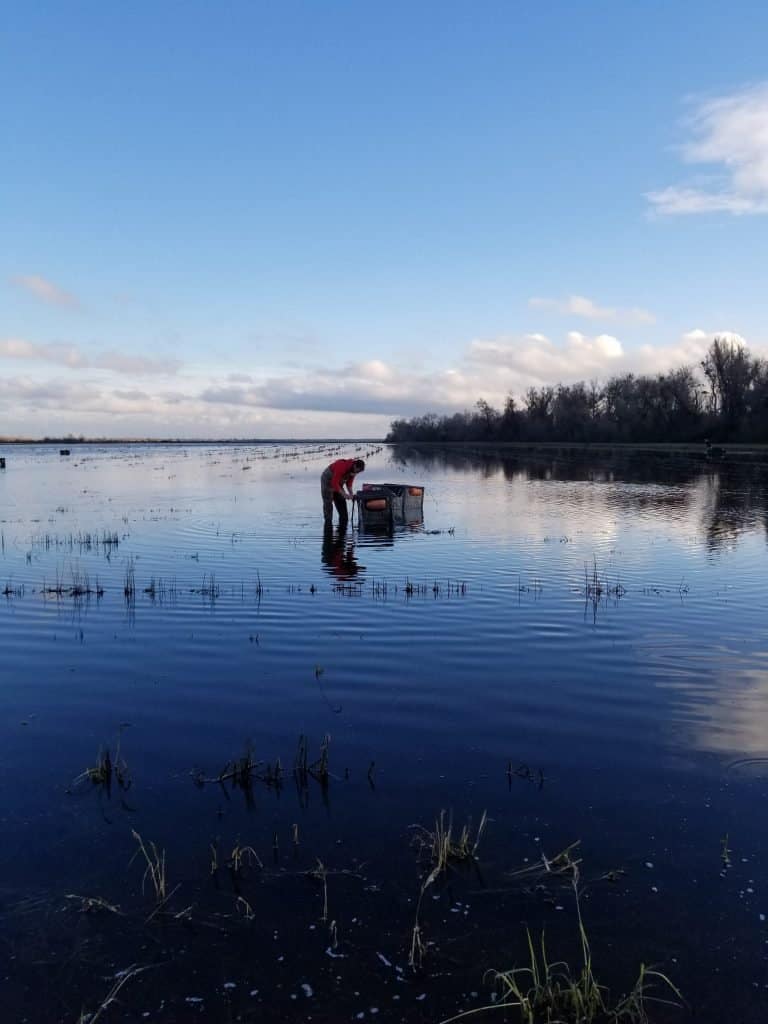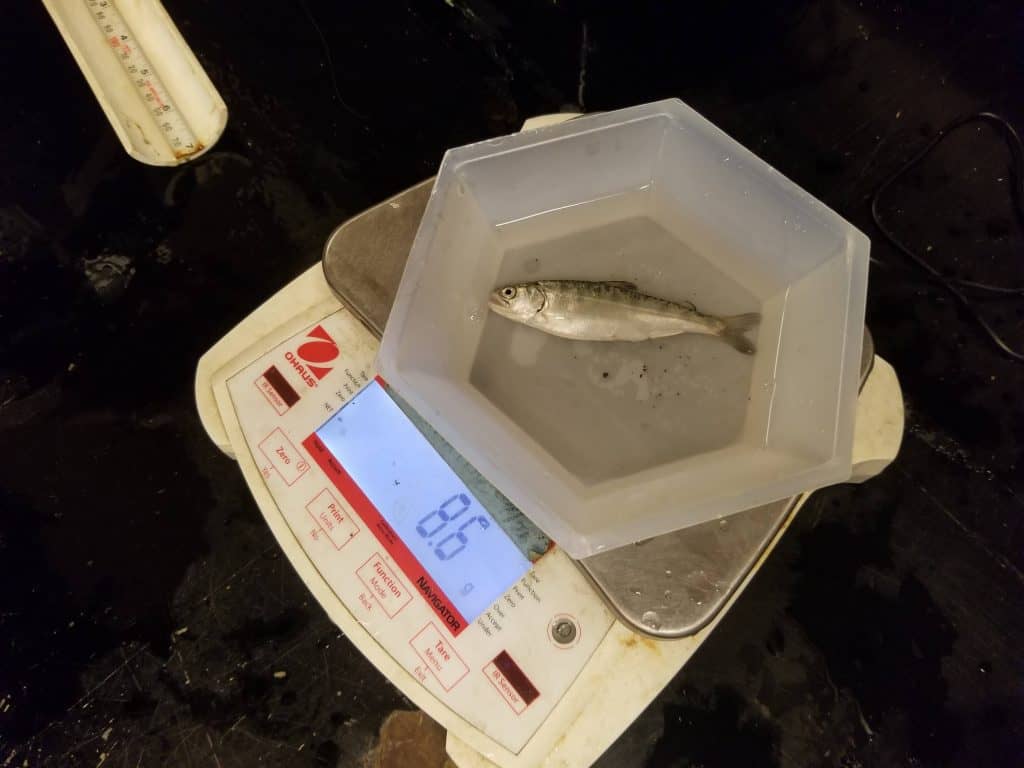Until just a couple of centuries ago, inland California was a lush tapestry of wetlands and floodplains that nourished a thriving ecosystem of fish. But as the state — and its vast agriculture industry — has grown, its waterways have been modified drastically. Rivers have been drained, fields dried out, levees and dams constructed. These engineering feats, coupled with extreme drought, have decimated natural habitats. Today, a shocking 83 percent of native fish species in the state are in decline.
Chinook salmon is one of these. “Winter runs used to have returns in the hundreds of thousands. Now a good year would be 10,000 fish,” says Andrew L. Rypel, a professor of fish ecology at UC Davis where he co-directs the Center for Watershed Sciences. Today, two of California’s three recognized Chinook salmon runs are listed under the U.S. Endangered Species Act. “We have had years that have just been in the hundreds. It’s a species on the precipice of extinction.”
Now, Rypel and his colleagues are helping the Chinook rebound by working with California rice farmers to recreate the natural floodplains in which the fish used to thrive.

The so-called “salmon-rice project” began a decade ago, when a motley group of scientists, rice farmers and conservationists joined together to answer a simple question: if they were to flood rice fields with water from the Sacramento River — effectively mimicking the region’s original ecological rhythms — would juvenile salmon take to the fields and grow?
First, they conducted some basic experiments to see whether salmon even lived in floodplains. Turns out, they did. The Nigiri Project – which began in the early 2000s, is still ongoing and involves some of the same people working on Rypel’s project — set out to determine whether salmon can survive on rice fields. In Asian countries, freshwater fish are often raised on flooded rice paddies, but it wasn’t known if salmon in particular were suited to that environment.
“The answer was that they not only survive, they grow extremely well,” Rypel says. “The fish were feeding on lush zooplankton that develop off the decomposed rice straws.” Rice straw is a rich source of carbon, and Rypel says that the density of zooplankton (normally microscopic) that develops in these winter-flooded rice plains is so high that you can actually see them with the naked eye, swimming around.
“It turns out that this kind of food is like an awesome steak for the growing salmon,” he says. UC Davis scientists found that these juvenile salmon survived at high rates in the flooded rice fields — 50 to 80 percent over the course of a month. “That’s excellent for baby fish,” Rypel says. They also grew two to five times faster than they grow in the Sacramento River.
With these data points in hand, Rypel and his colleagues teamed up with the California Rice Commission and California Trout in 2018 and began studying the viability of raising juvenile salmon in small experimental fields. The work was funded, in part, by the Natural Resources Conservation Service (NRCS), a wing of the United States Department of Agriculture that pays farmers and ranchers to do conservation work.

In 2021 the California Rice Commission and the UC Davis scientists got an additional $550,000 grant from NRCS to continue and expand upon their work. (The California Rice Commission and its partners are matching this grant.) Though this is the first year scientists are trying this out on production-scale rice farms, preliminary data is encouraging. For instance, in years like the past one, when the rice fields around the Sacramento River don’t flood naturally, farmers flood their fields with water from the adjacent canals and then scientists stock them with hatchery fish. They then track the fishes’ growth, survival and movements. Data so far indicates that these fish survive at a rate four to five times higher than lab-raised fish.
In the coming months, they’ll continue to track these hatchery salmon with tiny acoustic transmitters as they make their way out to sea. “One of the critical parameters that salmon managers are interested in is out-migration survival,” Rypel says. “That is: do they make it to the ocean? And how many?” The plan is to track 600 of the salmon to see if they make it to the Golden Gate Bridge and conduct a side-by-side comparison with lab-reared fish of out-migration survival.
Crushed by negative news?
Sign up for the Reasons to be Cheerful newsletter.Rypel says it boils down to two words: Big and early. “Being a baby salmon kind of sucks!” he laughs. “It’s really hard. Most of the fish die. You are dodging predators, you have to migrate a super-long distance. You need fat reserves.” Giving the salmon a head start while they’re still very young can have huge knock-on effects. “We think that by rearing them on these rice fields, we can get fish very big, very quick. If the fish can become smolts [juvenile salmon] earlier in the winter, they can ride the flows better and have better survivorship.”
Raising fish in rice paddies is nothing new. Rice farmers from China, Thailand, India and Northern Vietnam have been doing it for centuries – according to some evidence, for as long as 2,000 years.

But the project in California is actually more directly inspired by a series of bird conservation efforts dating back to the late 1980s and early ’90s. At the time, Pacific flyway birds — ducks, snow geese, egrets and all the other migratory birds that over-summer up in Alaska or Canada, and over-winter in the Central Valley — were in decline. For decades, rice farmers in the area regularly burned their leftover rice straw after the fall harvest. “People who lived in the area at that time will remember when the skies were black with smoke,” Rypel says. The air quality was poor, and carbon was being released into the atmosphere, as well.
Residents frustrated by poor air quality campaigned to stop this practice, and in 1991 a state law banned it. “Some smart people got together at that time and figured out that if you re-flooded the rice fields, you could naturally decompose the rice straw,” Rypel says. “At the same time, you could potentially provide habitat for the migratory birds that were on the Pacific flyway.” The NRCS began a program where they paid rice farmers to flood their fields instead of burn them, which was a win for the locals, a win for the birds and a win for the farmers, as it gave them a new revenue stream.
“I’m not a bird ecologist, but I work with a lot of bird scientists who have worked on this, and it’s probably one of the big conservation success stories in our country’s history,” Rypel says.
It was that program’s success that got fish ecologists scratching their heads. “Hey, if you can do this for birds, why can’t you do that for fish?” Rypel recounts. “We’ve got 83 percent of species declining in California. We know salmon use the floodplains. Is there a way to do this with fish?”
The answer appears to be a resounding yes. There are roughly 500,000 acres of rice under cultivation in the Sacramento Valley. “That’s a lot of habitat that’s potentially on the table there,” notes Rypel. He and his colleagues at UC Davis hope to replicate the model on more farms in years to come. “It’s a good example of how farms can work together with conservation scientists to make a difference.”






